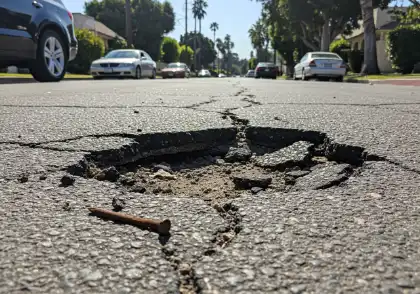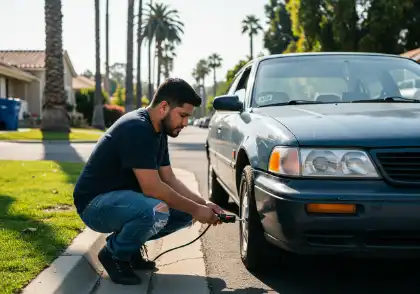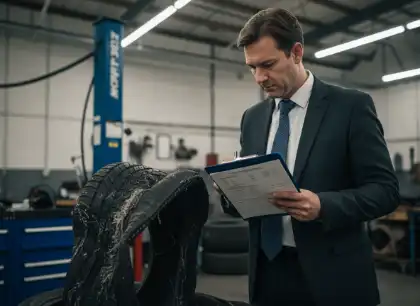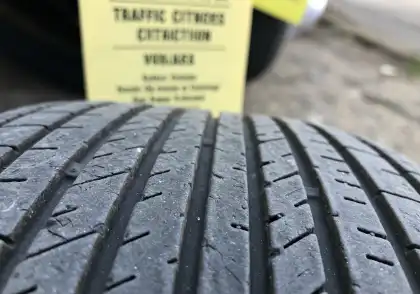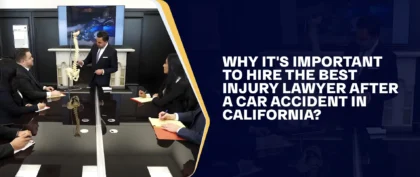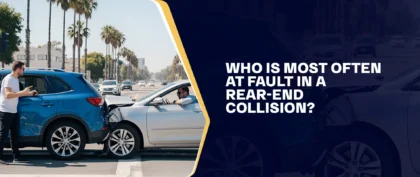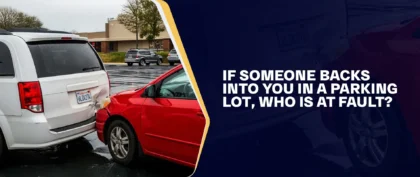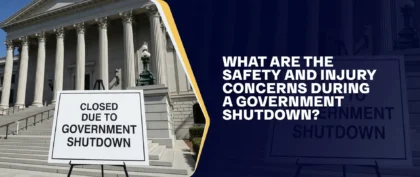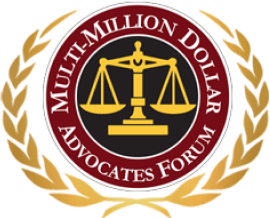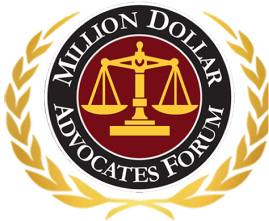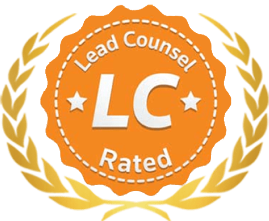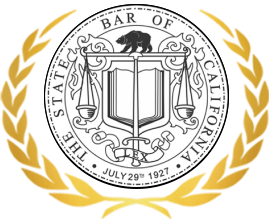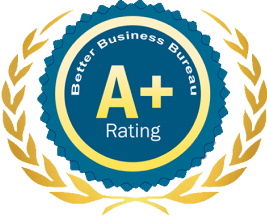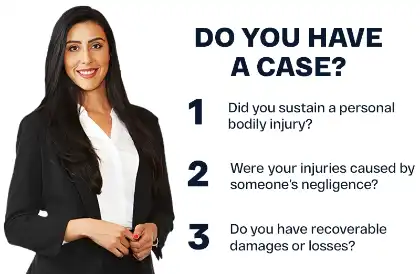TL;DR: Yes! Driving on a flat or cracked tire is dangerous, increasing the odds of a blowout, loss of control, costly vehicle damage, and even fires. Because liability can extend to drivers, shops, or manufacturers, California law lets victims seek fair compensation.
Table of Contents
Yes. Driving with a flat or cracked tire is extremely dangerous because it raises the risk of accidents, tire blowouts, costly vehicle damage, and even fires. In California, questions of tire blowout liability frequently arise when a flat or cracked tire results in a crash.
Victims of tire-related crashes may face hospital bills, lost income, and emotional distress. Liability can extend to multiple parties, including the driver, a repair shop, the tire manufacturer, or even a government agency if road hazards contributed to the accident. Acting quickly after a tire-related accident is important because evidence can disappear, and strict legal deadlines apply in California.
If you’ve been injured in a tire-related accident, understanding your risks and rights is the first step toward protecting your health, finances, and legal claim.
Key facts about driving with a flat or cracked tire:
- Flat or cracked tires increase the risk of crashes and blowouts.
- Damaged tires can cause costly suspension and wheel damage.
- Liability may involve drivers, shops, manufacturers, or agencies.
- Tire-related crashes often result in high medical and repair costs.
What Happens When You Drive With A Flat Or Cracked Tire
Tire blowouts are a common cause of accidents and insurance claims each year. In 2023 alone, the National Highway Traffic Safety Administration reported 646 deaths in the U.S. due to tire-related collisions. They also found out that underinflated tires are three times more likely to fail.
Many drivers don’t realize that driving on a flat can quickly turn into a serious accident. A single flat tire accident can cause loss of control, leading to collisions and costly damage. Other than that, it can cause serious harm to other parts of your vehicle. What many drivers don’t realize is that the damage spreads quickly. By the time you reach a repair shop, the cost and risks may already be much higher.
Here’s what can happen if you drive with a defective tire:
- Wheel Damage — When a tire is flat, it can’t properly carry the weight of your car, and the rim hits the road directly. As a result, they can bend, crack, or even break, leaving you with a repair bill that is far larger than just replacing a tire.
- Tire Beyond Repair — You can mend some flat tires if you catch them right away. However, the longer you drive on a flat, the more likely it is for the sides of the tire to get torn. Once that happens, you might be forced to buy a brand-new one instead of paying for a simple repair.
- Handling & Stability Problems — A flat tire takes away your car’s grip on the road. You will notice that it is harder to steer, accelerate, or stop safely, especially at higher speeds or in adverse weather conditions. Your vehicle may even start pulling to one side, making it harder to control.
- Suspension & Alignment Damage — Your tires play a big role in keeping your car’s suspension balanced. Driving with a flat puts uneven stress on the shocks, struts, and alignment. Over time, this issue can cause lasting damage to the vehicle’s systems, resulting in a rough ride and potentially costly repairs.
- Risk of a Blowout or Fire — If you continue driving on a flat tire, the friction between the road and the tire builds up heat. Too much heat causes the rubber to shred apart, which can lead to a sudden blowout. In extreme cases, that heat can even spark a fire, turning a bad situation into a dangerous one.
What Causes Flat Or Cracked Tires?
Knowing what causes flat or cracked tires can help you prevent accidents and determine who may be responsible if it occurs. Here are the most common causes of damaged tires:
- Road Hazards
- Potholes and Debris — Hitting potholes, nails, glass, or other sharp objects can puncture or crack a tire. Sometimes the damage becomes apparent right away; other times, it causes a slow leak that worsens over time.
- Impact Damage — Even when it’s not noticeable at first, hitting a hard object on the road can weaken your tires over time, leading to sudden failure.
- Tire Condition
- Worn-Out Tires — As rubber wears down, tires lose flexibility and strength. Old tires are far more likely to blow out than new ones.
- Excessive Wear — Tires exposed to heavy use or harsh conditions may deteriorate faster.
- Defective Tires — Manufacturing flaws or recalled products can create weak spots that increase the likelihood of blowouts.
- If a recalled tire is not replaced and causes a crash, the manufacturer may be held liable for the resulting damages.
- Tire Pressure Problems
- Underinflation — Driving on under-inflated tires causes them to overheat, increasing the risk of a blowout. Tire Pressure Monitoring Systems (TPMS) can help, but they typically only warn when the pressure is already very low.
- Overinflation — Too much air causes uneven wear and tear and reduces grip, raising the risk of failure.
- Maintenance Issues
- Improper Care — Failing to replace worn tires or skipping rotations increases the risk of a blowout.
- Failure to Replace — Once the tread is too thin, tires can no longer grip the road properly and become unsafe.
- Overloading
- Carrying more cargo than the tires can handle puts extra stress on them. Overloading is especially risky during summer road trips, when the heat exacerbates the pressure.
What Factors Affect Tire Aging?
Tires don’t last forever. Even if they appear fine on the outside, they gradually deteriorate over time. Several conditions influence how long they remain safe to use. Understanding these factors can help you maintain your tires properly and know when it’s time to replace them. Here are the key factors that affect tire lifespan:
- Heat — Tires age faster in warmer climates. Sunlight and coastal environments also speed up wear. Drivers in coastal or hot regions should consider this when deciding when to replace their tires.
- Storage — Tires that sit unused in a shop or garage age more slowly than those in service on a car. They still deteriorate, just at a slower pace.
- Spares — Even if rarely used, spare tires still wear out over time. Once a tire is mounted and inflated, it’s considered “in service” even if it has never touched the road. Heat, dirt, and weather can also make spares stored under a vehicle wear out faster.
- Conditions of Use — Everyday habits and driving conditions also play a role. Underinflated tires wear out more quickly, hitting curbs can damage them, and even a past puncture repair can affect their lifespan. Tires on a weekend car will age differently from those on a daily commuter.
What To Do If You Have A Flat Or Cracked Tire
If you have a flat or cracked tire, the safest course of action is to pull over and address the issue. Here are some steps you can take:
- Pull Over Safely — Find a safe spot away from traffic, like the shoulder of the road or a parking lot. Turn on your hazard lights to warn other drivers of your roadside emergency so that they can proceed with caution.
- Assess the Situation — Check the tire to determine the cause of the flat. If you don’t have the tools or aren’t comfortable making the change, call roadside assistance.
- Change the Tire or Call for Help — If you have a spare tire and the necessary tools, refer to your car’s manual for guidance. Ensure the vehicle is on level ground and use the jack properly. If you lack the necessary tools or are unable to change the tire yourself, call a tow truck or roadside assistance.
- Drive to the Nearest Repair Shop — After putting on the spare, drive slowly to the nearest repair shop. Remember, spares can’t handle long trips or high speeds; therefore, you will need to fix or replace the flat as soon as possible.
Even with these precautions, tire blowouts can sometimes lead to serious accidents, especially when trucks or larger vehicles are involved. In those situations, speaking with truck accident lawyers can provide clarity on whether faulty tires, poor maintenance, or negligence contributed to the crash.
Tips For Preventing Flat Or Cracked Tires
Flat tires aren’t always preventable, but proper maintenance can reduce the risk. Here are some steps to help keep your tires in good shape:
- Check Tire Pressure Monthly — Use a tire pressure gauge to inspect all your tires, including the spare, at least once a month. Do it when the tires are cold, at least three hours after driving. Low pressure causes tires to wear out more quickly, reduces fuel efficiency, and increases their susceptibility to punctures.
- Inspect & Rotate Tires Regularly — Rotating your tires every 5,000 to 10,000 miles helps them wear evenly. A good rule of thumb is to rotate them whenever you get an oil change. While you’re at it, look for low tread (less than 3/32 inch), cracks, bulges, or bubbles.
- Do Not Exceed the Load Limit — Tires can only support a certain amount of weight. Check the sidewall for the maximum load capacity and pressure. Excess weight puts stress on the tires and increases the risk of a blowout. If you’re carrying extra cargo, adjust the pressure accordingly, but never exceed the maximum allowable pressure.
- Watch Out for Road Hazards — Potholes, nails, and other debris can damage your tires. Even if they don’t cause a puncture, they can weaken the tire and lead to bigger problems. Scan the road ahead and avoid hazards whenever you can. If you hit something sharp or notice a sudden change in handling, slow down cautiously. Maintain a safe distance to stop, allowing you to pull over without putting yourself or others at risk.
Tire Regulations In California
In California, it is a traffic offense to drive with tires that have worn treads. The law requires:
- At least 1/8 inch of tread depth on front tires.
- At least 1/16 inch of tread depth on rear tires.
Tires that do not meet these requirements are considered “bald tires.” Driving with bald tires is illegal and may result in a traffic ticket.
Determining Liability In Flat Tire Or Blowout Accidents In California
When a tire blowout causes an accident, identifying who is responsible is important for any compensation claim. A personal injury lawyer can assist in investigating the situation and identifying who might be at fault, which could involve various parties depending on the cause.
- Vehicle Owners — If the blowout happened because the owner failed to maintain their tires, they may be held responsible. Examples include driving on worn tread or using incorrect tire pressure.
- Tire Manufacturers — Defects in the design, materials, or production of a tire can make the manufacturer responsible for an accident. Victims who suffer defective tire injuries may have grounds to pursue claims against the manufacturer.
- Maintenance Providers — A mechanic or service shop may be liable if improper installation, repair, or maintenance of the tires led to the blowout.
- Government Entities — Courts may hold a government agency responsible if hazards, such as poorly maintained roads or potholes, caused the blowout.
- Other Drivers — Another driver may be found at fault if their actions caused the blowout, such as losing cargo on the road.
Car accident lawyers can help investigate the details of a road accident to identify potentially liable parties and guide you through the claims process. Their experience in handling complex cases involving car defects, maintenance issues, and collisions can be helpful in strengthening your legal claim.
Understanding Fault In California Tire Blowout Accidents
California follows an at-fault system for accidents. Under this system, an injured person must prove that another driver was responsible for their injuries and subsequent losses to pursue compensation.
The state also applies the rule of pure comparative negligence. More than one person can share responsibility for an accident, and compensation is reduced based on the percentage of fault each person bears. For example, if a court finds you 30% at fault, you may still recover 70% of your damages.
Legal Claims Tire Blowout Victims Can File
Victims may pursue defective tire injury claims if a blowout was linked to design flaws, faulty materials, or a recalled product. The type of claim will depend on what caused the accident and who is responsible:
- Compensation Claims — Victims may seek damages for medical expenses, vehicle repairs, lost wages, pain and suffering, and other related losses.
- Product Liability Claims — If a defective tire caused the blowout, victims can file a claim against the manufacturer or distributor. These claims argue that the product was unsafe when used as intended.
- Negligence Claims — If the accident resulted from another party’s negligence, such as a driver, mechanic, or road authority, victims may pursue a negligence claim to hold them responsible.
When To Contact A Lawyer After A Tire-Related Accident In California
One of the first questions that often comes to mind after an accident is, “Do I need a personal injury lawyer?” In most cases, the answer is yes.
It is recommended to contact an injury lawyer after an accident caused by a flat or cracked tire, especially if you wish to seek guidance in pursuing damages. Early involvement allows them to preserve important documents before they are lost or destroyed. This evidence often includes the damaged tire, maintenance records, and accident reports.
Legal assistance may be beneficial in certain situations. If an accident results in serious injuries or fatalities, consulting an accident lawyer can help reduce the stress during this difficult time. It’s also advisable to seek legal guidance if a recently purchased or repaired tire caused the accident. Additionally, legal help can be advantageous if multiple parties dispute fault.
Speaking with defective tire injury attorneys can help you evaluate potential claims, from negligence to product liability. They can also help you manage important deadlines that may apply to your case.
Frequently Asked Questions About Tire Blowouts In California
Here are common questions about legal and insurance issues related to tire-related accidents in California. If you have more specific questions, don’t hesitate to contact us. You may be looking for free accident lawyer advice online to learn about your rights. You can receive a complimentary initial consultation, during which we will evaluate your case and discuss potential legal options with you.
Is Damage From A Tire Blowout Covered By Insurance?
It depends on your policy and the cause of the blowout. Here is a general overview of how coverage may apply:
- Comprehensive Insurance — Covers the damage if something other than a collision caused the blowout, such as road debris or hazardous conditions.
- Collision Insurance — Specifically applies if the blowout directly led to an accident with another vehicle or object.
- Manufacturer’s Warranty or Product Liability — May apply if the tire failed because of a defect in its design or production. In such a situation, the manufacturer could be held liable.
Most insurance policies do not typically cover the simple replacement of a worn-out tire. Coverage generally applies only if the blowout results in vehicle damage or is connected to a defect or accident.
Since liability may fall on the driver, tire manufacturer, or repair shop, it is advisable to consult an accident lawyer. They can help determine who may be responsible and guide you in pursuing damages.
What Is The Minimum Tread Depth For Tires In California?
“Tread” is the part of the tire with ribs and grooves that grips the road. Under the California Vehicle Code, the minimum legal tread depth is:
- 4/32 inch (1/8 inch) for tires on the steering axle of trucks, buses, and vehicles with a gross weight rating over 10,000 pounds.
- 2/32 inch (1/16 inch) for all other tires, including passenger vehicles.
If the tread is below these limits, the tire is considered unsafe and unlawful to use on California roads.
Quick Tip – The Penny Test
Place a penny headfirst into a groove of your tire tread. If you can see the top of Lincoln’s head, the tread is less than 2/32 inch, and the tire needs to be replaced.
What If Multiple Parties Are Liable For The Tire Blowout Injury?
Sometimes, more than one party can be responsible for a tire blowout injury. For example, the tire manufacturer could be at fault for producing a defective tire, while the seller might share responsibility if they knowingly sold it. A jury will determine how fault is divided among all parties involved. The total of all assigned percentages of fault must always equal 100.
In cases involving commercial vehicles, liability can become even more complex. A trucking company, its maintenance provider, or a tire manufacturer may all share responsibility for the blowout. Victims may turn to truck accident lawyers in these situations to help sort through the evidence, assess liability, and pursue claims against the responsible parties.
Contact A Defective Tire Injury Attorney For Legal Help
Driving with a cracked or flat tire can lead to higher repair costs or serious accidents. Victims of tire-related accidents may suffer painful injuries and emotional distress. They might also face mounting medical and car repair bills. Moreover, determining who is at fault can be complicated. Having a skilled accident lawyer by your side can help you protect your rights and pursue rightful compensation under California law.
At Arash Law, our defective tire injury attorneys have years of combined experience handling tire-related accident claims across California. Our team can manage the legal process, including talking to insurers and building your claim. We can help you pursue compensation for the damages you sustained in the accident, allowing you to focus on your physical recovery.
Beyond tire and auto claims, we represent clients in rideshare collisions, product defect cases, and wrongful deaths. We also have slip and fall lawyers to assist with injuries resulting from falls.
To discuss your case and understand your rights, call the AK Law Firm at (888) 488-1391 or complete our “Do I Have A Case?” form. We offer a free initial consultation and assist clients regardless of immigration status.

